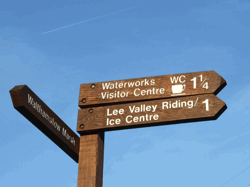 |
|
In 2012 various botanical surveys of Lea Marshes were compared. To view this comparison table click this link. | |||
| Walthamstow Marshes: Plants |
THE FLOWERING AND NON-FLOWERING PLANTS OF WALTHAMSTOW MARSHES
As a field botanist, I was brought up on the Marshes. This is where it all began. Living only a few minutes walk away, I have, since early childhood, paid many hundreds of visits to the area in all seasons and weather conditions, I have seen golden Summer sunrises glow gently upon shoulder-high wreaths of soft light mist. I have seen black storm and tempest sweep like savage seas across the swirling reed pastures. From the Great Blizzards of 1963 to the Great Drought of 1976, no mere climatic extreme has yet dramatically changed the rich and delicately-balanced fauna and flora of Walthamstow. Man alone now holds the balance.
During my own formative years of learning the British Flora, Walthamstow Marshes played a more active part in my life than any other locality. Each visit revealed new discoveries, new challenges, new species to be identified and remembered. No longer just weeds, they became vegetables, spices, salad greens, herbs, medicinal plants, scented plants, living fossils, deadly poisons, models and mimics, garden escapes, canary-seed aliens, and foreigners from every continent of the world. Every plant became an individual and a character. Poetically and even humorously named flowers abounded on all sides. I learnt that a grass could be a Fox-Tail or a Cock's-Foot, and I still know a bank where, although there's no wild thyme growing there, we can still find Cat's-Ears and Mouse-Ears living together in perfect harmony. Children have often taken an interest in my searchings; and I'll always remember one young boy who said, "Well, nature's the best thing, really," as though already accepting that the process of growing up would one day inevitably force him to substitute the purely commercial recreations which one would assume were all his parents may have known. Certainly, as a society, we are now gradually developing a more sympathetic attitude towards nature as being a rewarding interest for young adults, too, not just something which children are eventually expected to "grow out of". This is encouraging, and I certainly feel that Walthamstow Marshes could serve no better social function in London than to help foster this attitude as widely as possible.
And so, from the early days of separating a Timothy from a Yorkshire Fog, I gained by degrees, sufficient confidence and experience with wild plants to contact, and then work for, botanic gardens and museums, to join world-wide natural history societies, and to write papers on notable discoveries and habitats, But there was never any question of "growing out of" Walthamstow, or leaving it behind as a childhood phase that had served its purpose.
Twenty years of visits have not exhausted the excitement and interest of the area, nor even would twenty more. Its very vitality lies in the subtle changes continually occurring there within the natural processes of evolution and plant competition. Species increase and decrease, old ones go, and new ones arrive. The flora is never static. Difficult groups like the Dandelions and the Michaelmas Daisies have still got even Kew Gardens puzzled as to precisely how they should be identified. And a great scope exists for sharing the area's immensely varied plant life with children, students and interested adults, from everywhere around.
In adult life, one's horizons continually widen, and so my regular forays and botanical travels and experience elsewhere (including abroad) constantly put the Walthamstow scene in a new perspective. Yet there must be very few inhabited localities anywhere on the entire globe where we would not easily find at least one of the plants on our appended Walthamstow species list. Thus the area can always serve as a point of reference, and a standard for making comparisons. For me, above all, there is the added deep gratitude that this is where a whole lifetime of guaranteed joy and fascination was originally born and bred.
Walthamstow Marshes may be our very last relic of the original marshes and water meadows upon which London itself was born. Morally, socially, and ecologically, it would be a tragedy to have this ancient land destroyed for ever.
 | Click to go to next section |